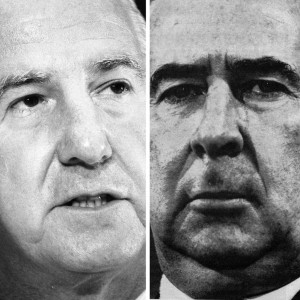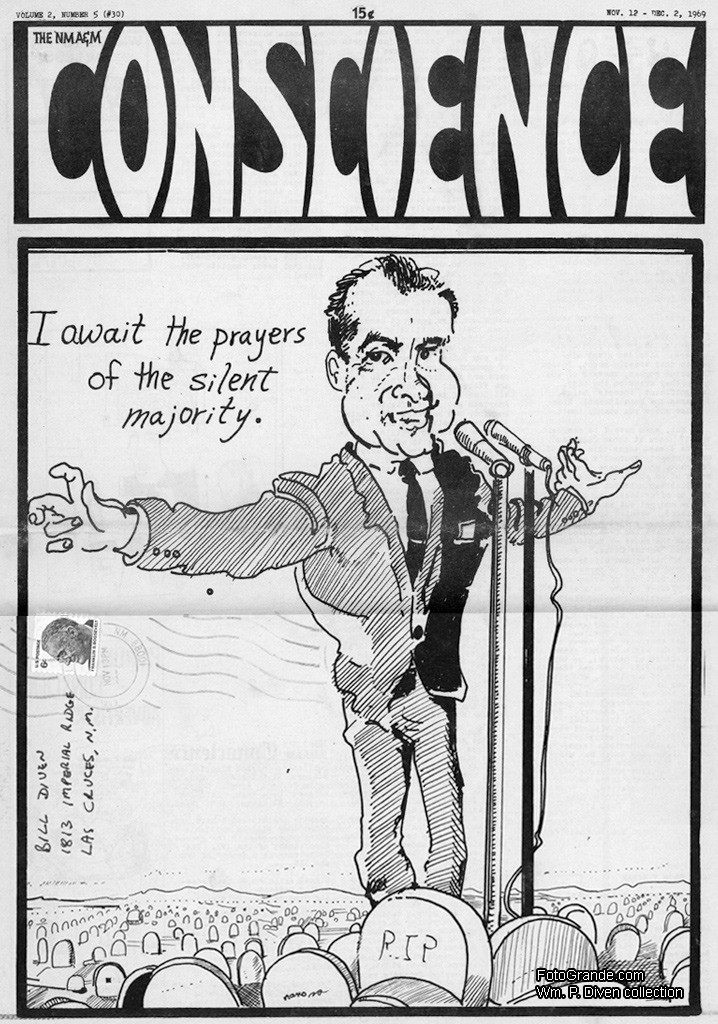While I miss some aspects of the 1970s, my hair and the Allman Brothers Band, for example, the Nixon zombies roaming Albuquerque City Hall are not welcome here in 2015.

Spiro Agnew (left), Gerald R. Ford Presidential Library and Museum, image No. T25035c1-27; John Mitchell (right), photo by Steve Northrup in Time Magazine, April 30, 1973, author’s collection.
Among the undead is Attorney General John Mitchell, part of the team that shilled for President Nixon by attacking enemies real and imagined in and out of the news media. He’s the one who said Washington Post publisher Katherine Graham is “gonna get her tit caught in a big fat wringer” over exposing a connection between the Watergate burglary and the Nixon re-election campaign. By that time, Mitchell ran the Committee to Re-Elect the President, wonderfully known as CREEP.
Then there was Vice President Spiro Agnew. He dismissed intellectuals as “an effete corps of impudent snobs,” the media as “nattering nabobs of negativism” and “ultraliberals” for “pusillanimous pussyfooting on the critical issue of law and order.”
(Translations: “Pretentious disrespectful self-important people.” “Chattering big-shot pessimists.” “Fearfully cautious.” At least Mitchell spoke English.)
As many suspected, Mitchell, Agnew and their colleagues covered for a criminal organization run from the White House. Agnew disappeared as a convicted tax cheat while under investigation for accepting bribes before everything collapsed in 1974, and Mitchell was under indictment but not yet imprisoned when Nixon dodged impeachment by resigning in disgrace and fleeing for a friend’s mansion in California.
Those were hopeful and dreadful times with political assassinations, leftist bombings, rising feminism, a public mobilized against a dead-end war, young people thinking they could change the world and rioting in the streets as police abuses and racism boiled over.
While what we now call the mainstream media generally defended the status quo, underground papers sprang up around the country from Los Angeles and New York to backwaters like Las Cruces, N. M., where activists launched the NMA&M Conscience. Las Cruces leaders freaked, of course, ferreting out anonymous Conscience editor Gordon Solberg and firing him from his university job. Mayfield High School suspended a student for selling the paper — off campus and after school.
“My king. The barbarians to the west say “Ne Nuntium Necare,” which means do not kill the messenger. … It was my unlucky lot that condemned me to be the messenger bearing bad news.” — Sophocles, Antigone, ca. 442 BC
Even now, as the powerful have done throughout time, if you can’t defeat the message, trash the messenger.

NMA&M Conscience, v. 2, no. 5, Nov. 12-Dec. 2, 1969. Author’s collection. The title reflects an earlier name for New Mexico State University: New Mexico College of Agriculture and Mechanic Arts. Nixon claimed the support of the “silent majority,” that is people not protesting the Vietnam War and his policies.
And so Albuquerque’s Chief Administrative Officer Rob Perry, in an interview with KOAT-TV, attacks the weekly ABQ Free Press as an underground paper and people like the public figure quoted therein as “dangerous because they come up with ideas that can lead to very, very poor results.”
Who has Perry, previously the city’s chief public safety officer, so riled up? That would be Pete Dinelli, himself a past chief public safety officer, who dares to tell the Free Press the Albuquerque Police Department needs a complete housecleaning of top brass down to the lieutenant level.
For good measure Perry labels Dinelli, a former assistant district attorney who lost the last mayoral election to Perry’s boss, a “disgruntled unelected political figure” and calls his suggestion for fixing APD “asinine.”
Disclosure: I occasionally write for the ABQ Free Press, which notes it is not underground but located on the second floor of an office building. I’ve written one story about APD for the paper.
Meanwhile Perry and Mayor Richard J. Berry wade in the national muck over cops killing civilians under questionable circumstances. While Albuquerque has been spared the riots of Baltimore and Ferguson, it stews in the same roiling cauldron. Under their watch the city continues to pay out for wrongful-death lawsuits from bereaved families, the latest last month for $6 million, bringing the total to around $30 million.
The U.S. Department of Justice savaged APD over heavy-handed, unconstitutional and too-frequently fatal policing, which led to a federal monitor of the department under a court agreement approved last week. Separately three investigations, two of them internal, raise questions of conflict of interest and dodging purchasing rules by a recent APD chief who, as he was retiring, set up — “greased,” according to one of his emails — a no-bid contract for a company that then put him on its payroll.
In the 1980s APD was home to the ringleader of a criminal organization of cops and ex-cops engaged in multistate commercial burglaries and linked to a couple of homicides. APD’s intelligence unit also kept secret files on political figures but after word got out managed to burn the records during a momentary gap between court orders to preserve them.
(Jim Baca says when he ran for mayor in the 1980s, he spurned an offer from an APD deputy chief for files containing dirt on his opponent, car dealer Ken Schultz. Shultz won, the deputy chief became chief, Baca became mayor later, and Schultz crashed and burned as the admitted bagman turned government witness in a $4 million corruption scandal that sent others to federal prison.)
More recently a sex-crime charge against a judge disliked by some at APD shamed the jurist and got him off the bench before the charge was dismissed. And the state attorney general suggests political influence in a criminal investigation of the district attorney who earlier this year charged two APD officers with murder in the killing of a homeless and mentally ill man.
Is APD as corrupt and criminal now as it was in earlier times? That’s anybody’s guess. Are Perry and Berry keeping the lid on something as deep and dark as the Nixon White House? Probably not, but as we say here in New Mexico: ¿Quién sabe? Who knows? There’s no question APD is in disarray, however, and anyone approaching the bunker of City Hall posing questions and suggesting solutions is only the messenger, not the issue.


Good Piece. The difference here and now is that there is not Washington Post in our city to ferret out the truth. Certainly not the Journal. And frankly, ABQ Free Press is not at the point where there is any critical mass of readers.